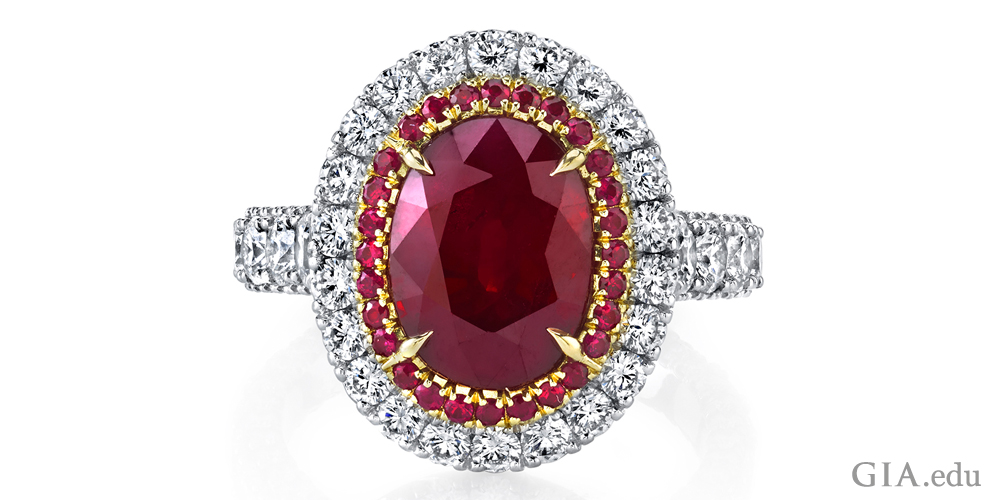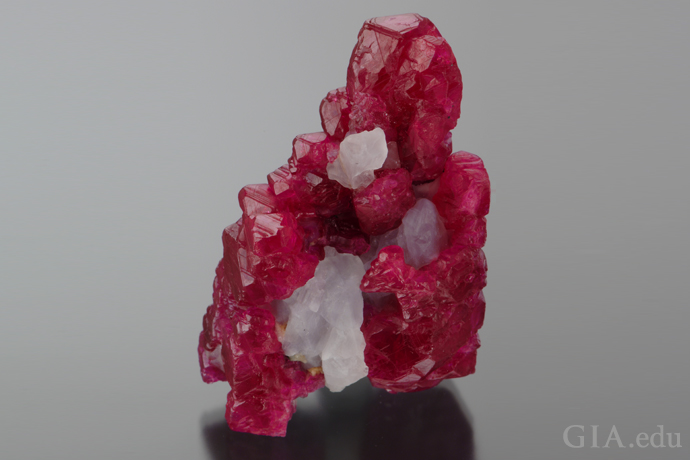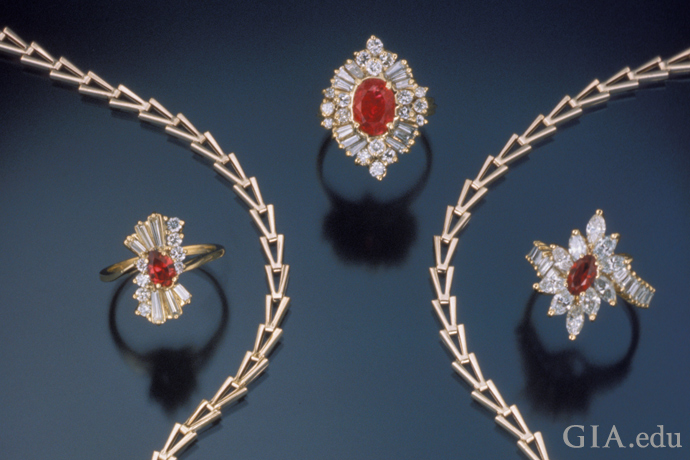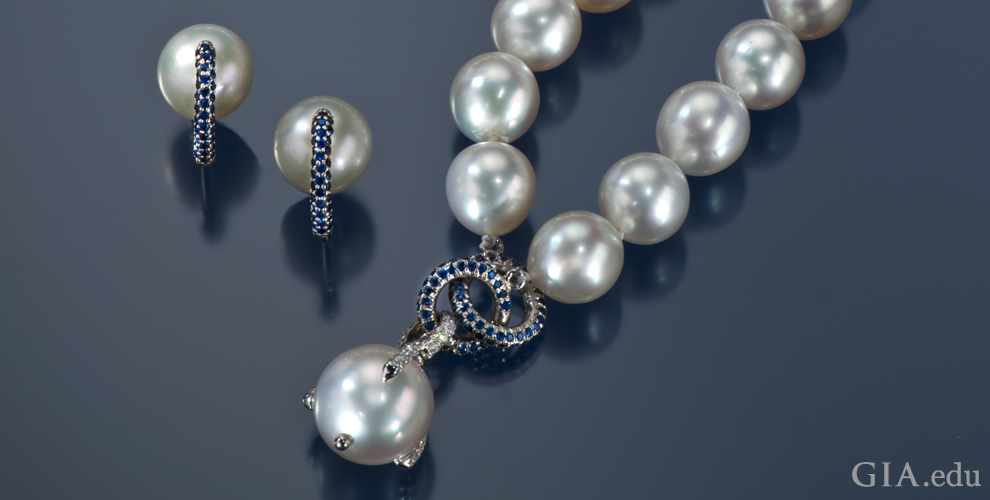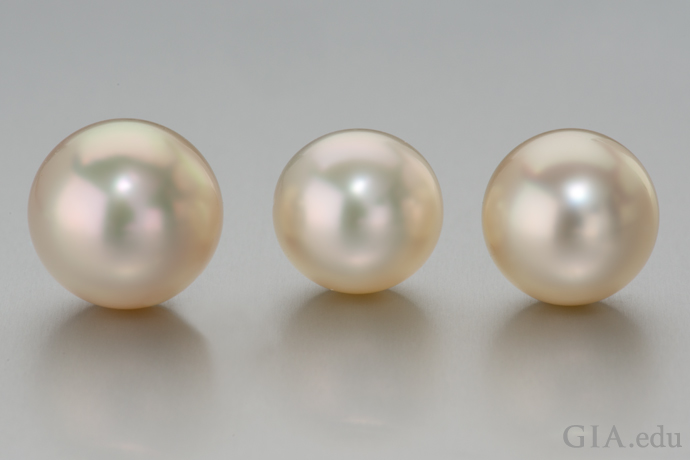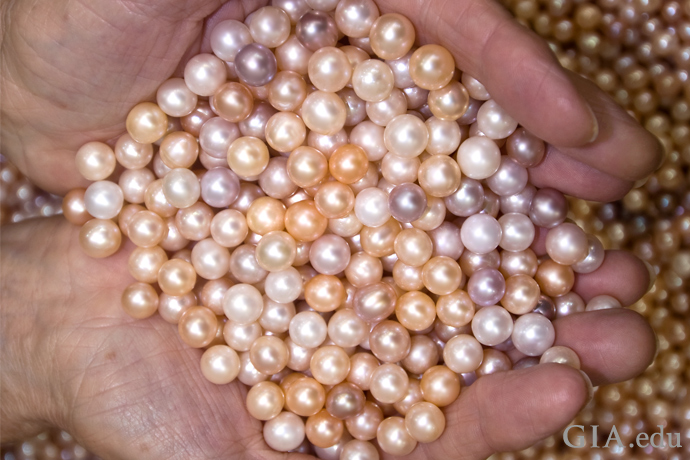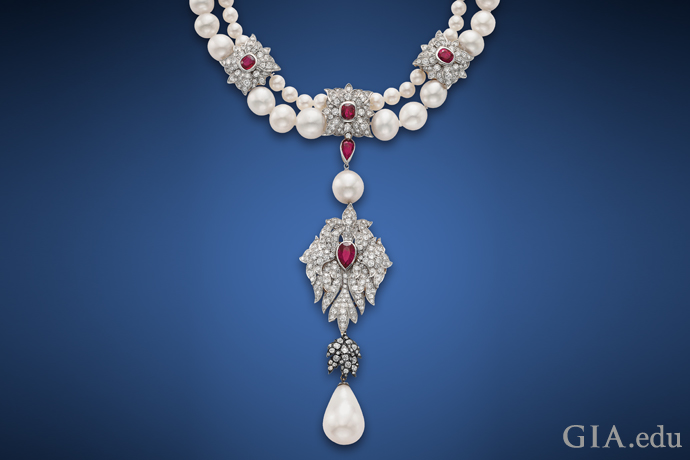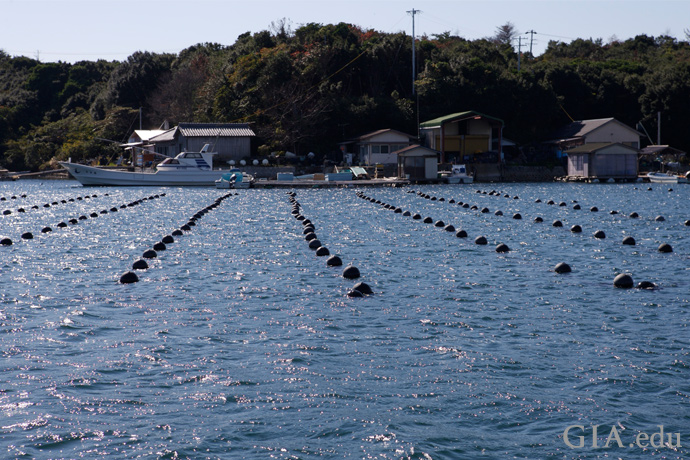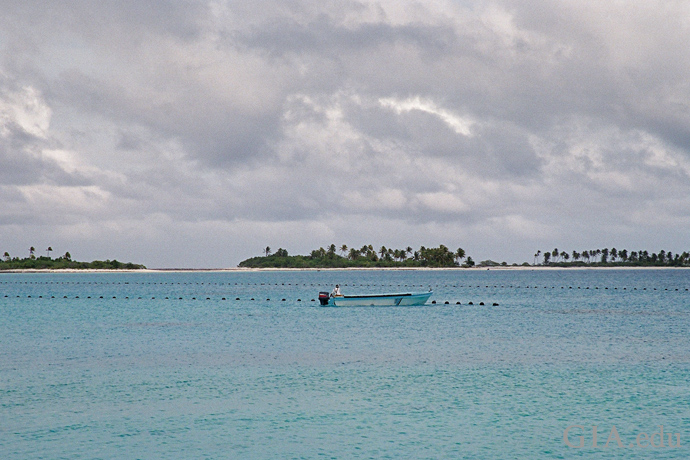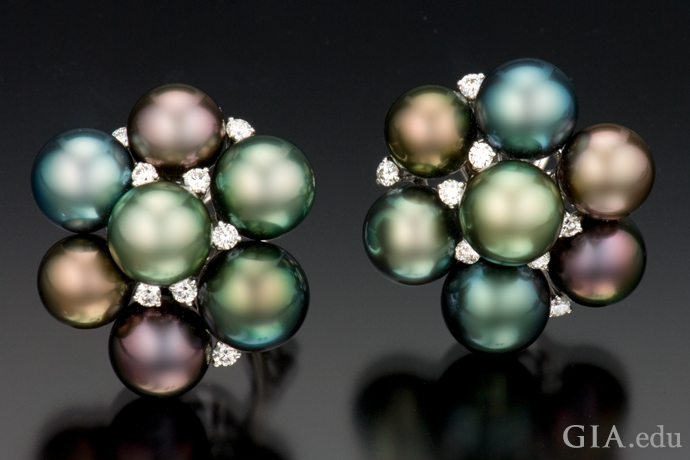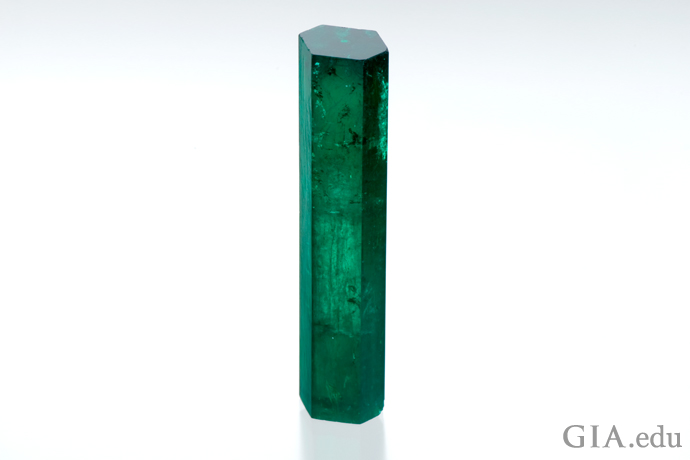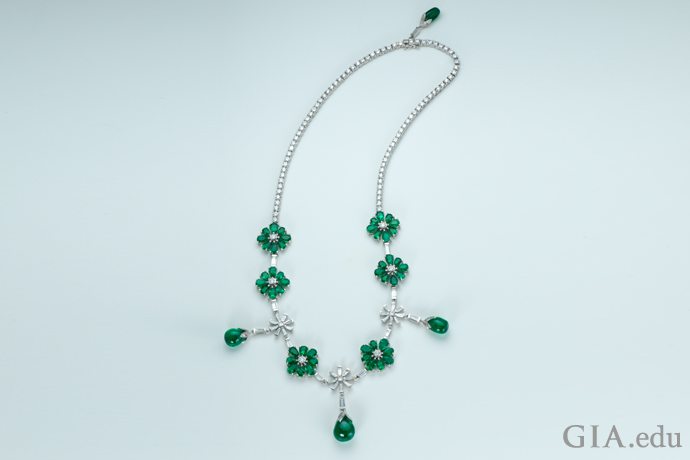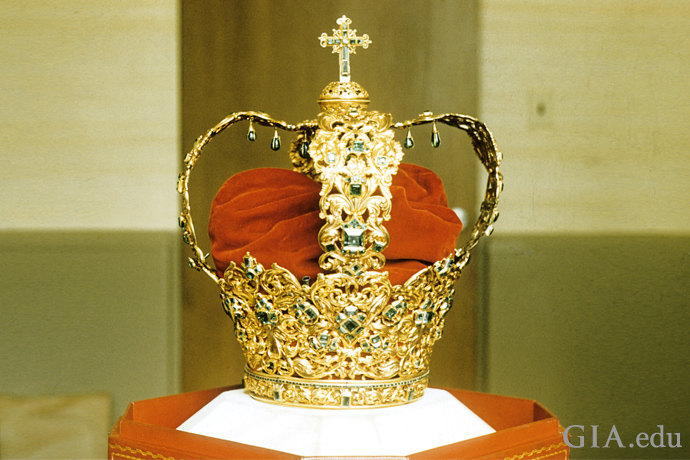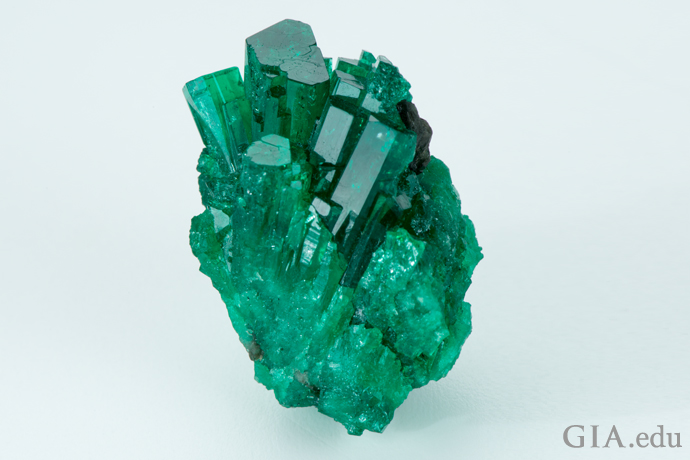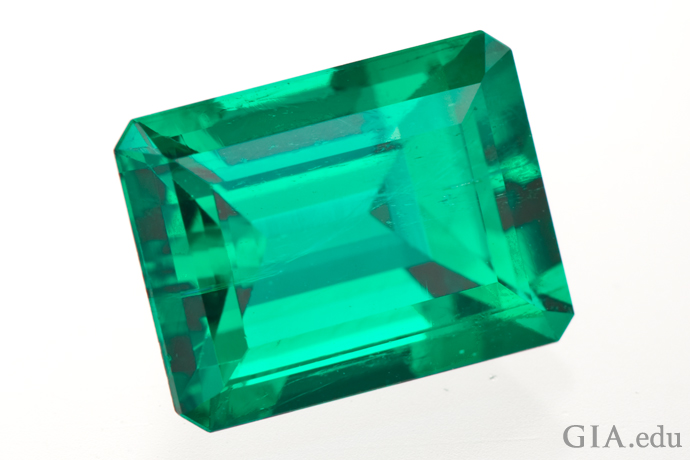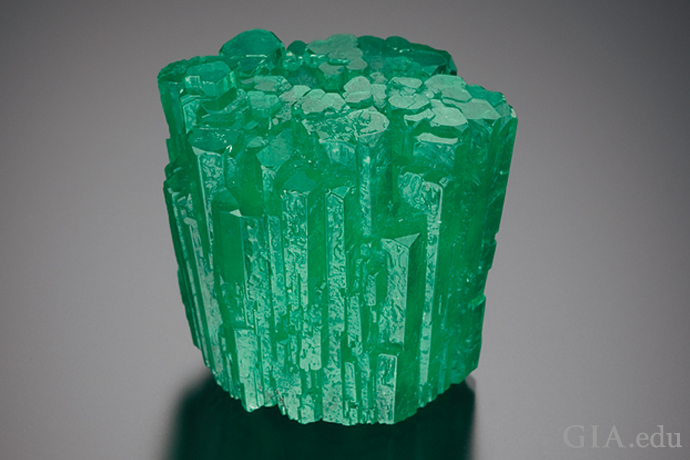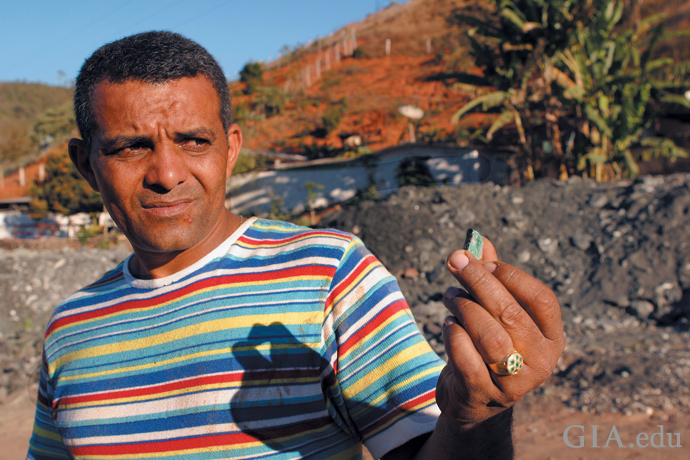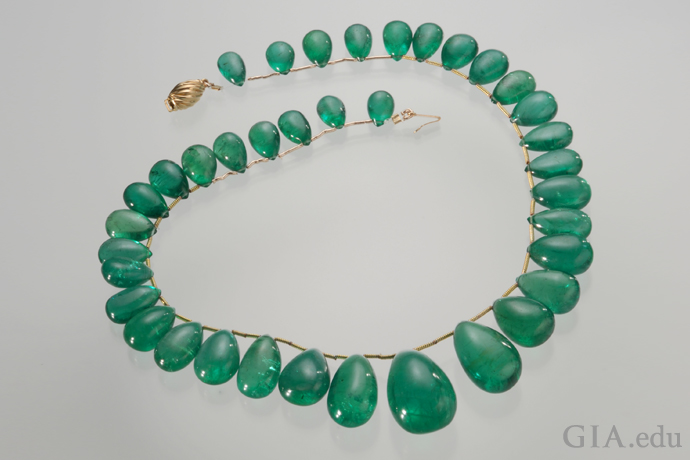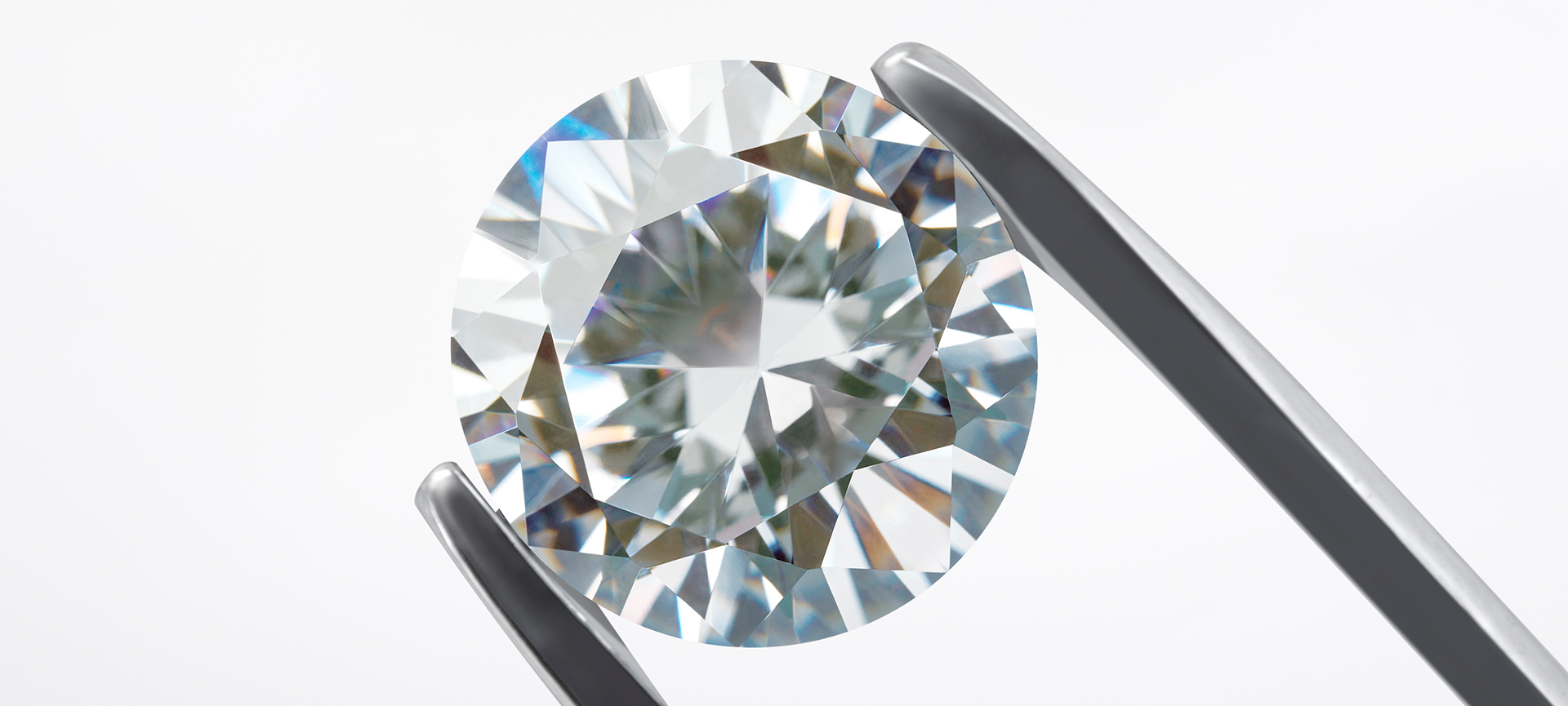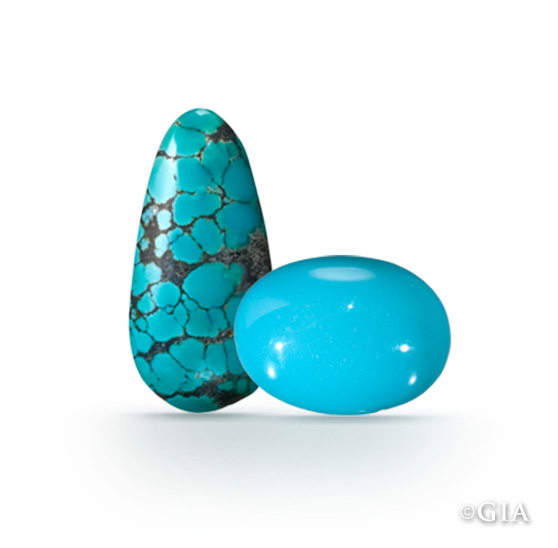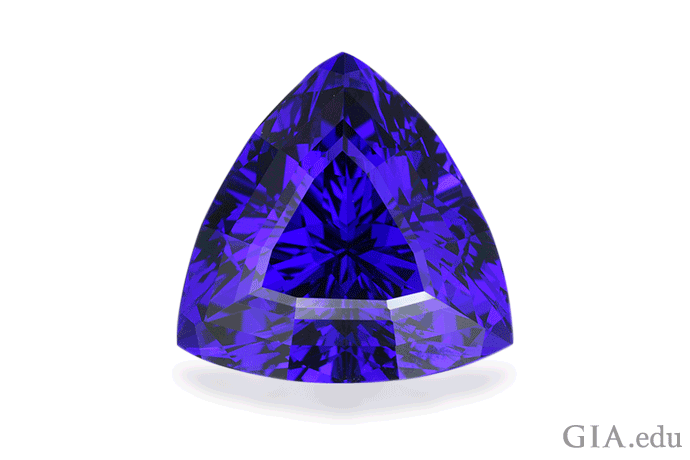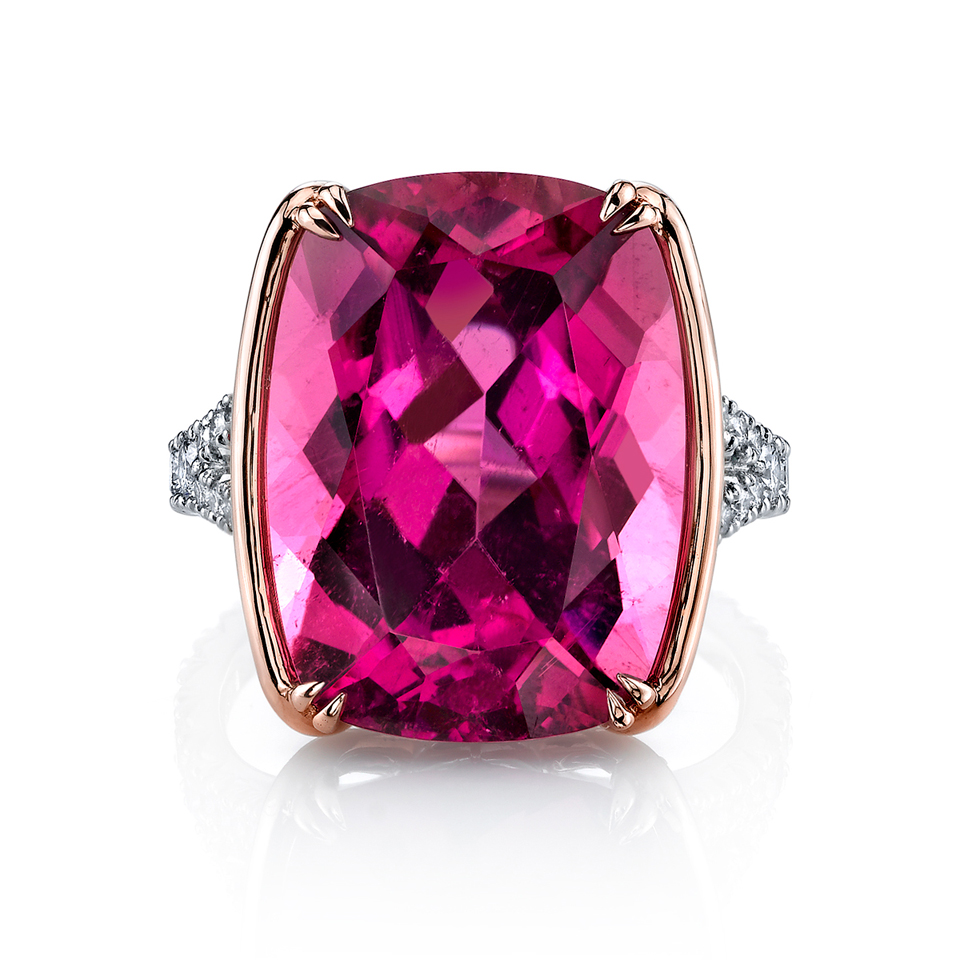The September birthstone is sapphire – a gem that’s been cherished for thousands of years. Sapphire is one of the most popular colored stones because of its beautiful blues. It also comes in a rainbow of other colors. Here’s how to pick a stunning one.
In this post, we cover:
Gemological Properties of Sapphire
Sapphire History & Lore
Where Sapphire Comes From
Qualities to Look for in Sapphire
Sapphire Care & Cleaning
Gemological Properties of Sapphire
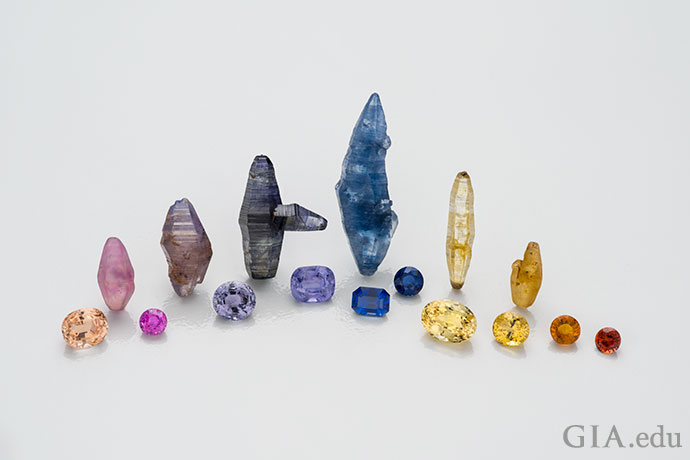
The colors of sapphire enchant. Faceted stones (from left to right): 6.36 carat (ct) pinkish orange “padparadscha,” 1.63 ct pink, 4.76 ct violet, 5.43 ct violet-purple, 3.03 ct blue, 2.12 ct blue, 8.06 ct yellow, 3.46 ct yellow, 2.00 ct orange and 1.01 ct deep orange. Photo: Robert Weldon/GIA. Courtesy: Dr. Edward J. Gübelin Collection and Bill Larson, Pala International
The September birthstone, sapphire, comes in a range of colors in addition to the familiar blue. Called “fancy sapphires,” these are violet, green, yellow, orange, pink, purple, black, brown and intermediate hues. Sapphire can be colorless, too. That’s because the gem belongs to the mineral species corundum, which is composed of aluminum and oxygen. In its purest state, corundum is colorless. However, colorless corundum is rare. Most corundum contains trace amounts of additional elements including iron, titanium, magnesium, vanadium, and chromium that replace aluminum in the corundum structure. The coloration of blue and fancy sapphires involves interactions between these impurity elements—sometimes in combination with imperfections in the gem’s crystal structure—that absorb light and impart color into this otherwise colorless mineral.
Blue in sapphire requires interaction between impurities of iron and titanium, whereas chromium is key to the pink in pink sapphires and the red color of ruby, which also belongs to the corundum mineral species. (Red corundum is the only color not called sapphire – it is called ruby.)
Any color of corundum can show a phenomenon called asterism, or the star effect. This phenomenon usually appears as a six-ray star pattern across a cabochon-cut stone’s curved surface when the gem is examined in direct sunlight or with a single intense light. Asterism is caused by the presence of numerous tiny, needle-like inclusions of rutile or hematite oriented in specific directions.

The star, or asterism, in this 5.43 ct blue sapphire is heavenly. Photo: Robert Weldon/GIA. Courtesy: Fu Gemstone Import, Seattle, WA.
Another interesting variety is color-change sapphire. These fascinating stones appear to be a different color under different lighting conditions, most often going from violetish blue in daylight or fluorescent lighting to deep reddish purple in incandescent light. Their presence adds a special dimension to the options available for the amazing September birthstone.
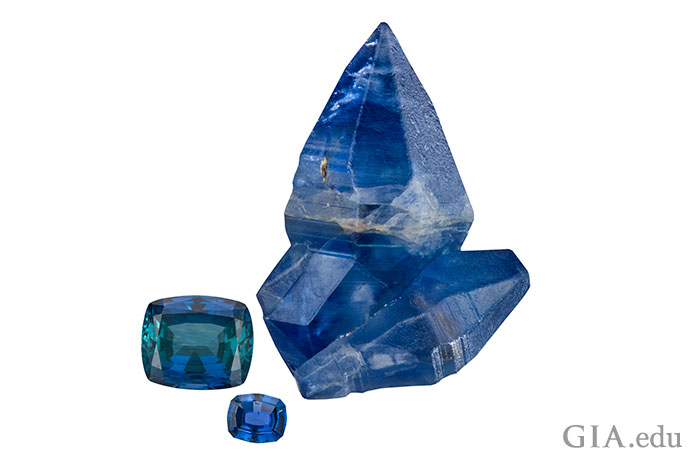
Pictured here are a cluster of sapphire crystals from Myanmar, a faceted blue-green sapphire from Kenya and a faceted blue sapphire from Montana. Photo: Robert Weldon/GIA. Courtesy: (Rough) Bill Larson, Pala International; (Left) Columbia Gem House; (Bottom) Dr. Edward J. Gübelin collection.
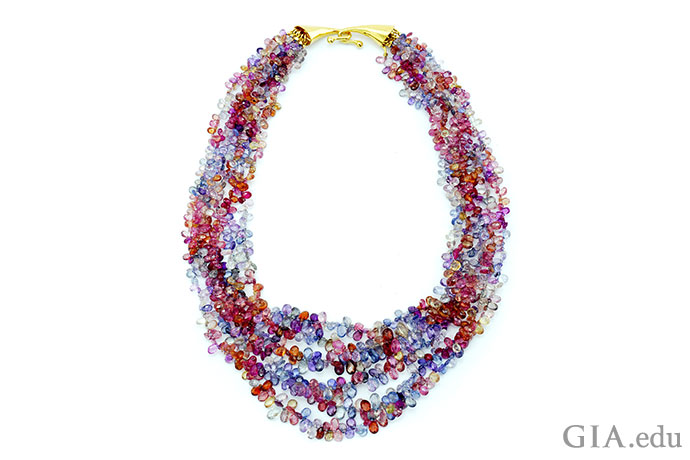
Some of the many colors of sapphire are on display in “Dawn” – a one-of-a-kind necklace that features 450 carats of sapphire beads. Courtesy: Denise James
Sapphire History & Lore
The September birthstone has traditionally symbolized sincerity, truth, faithfulness and nobility. For countless centuries, sapphire has adorned royalty and the robes of the clergy. The elite of ancient Greece and Rome believed that blue sapphires protected their owners from harm and envy. The clergy of the Middle Ages wore sapphires because they symbolized Heaven.
The September birthstone was also reputed to have healing powers. Medieval Europeans believed that sapphire cured plague boils and diseases of the eye. It also was thought to be an antidote to poison.

A dragonfly brooch studded with a 38.82 carats of pink, green, blue and yellow fancy sapphires and 5.74 carats total weight of diamonds might make you believe in the magical powers of the gem. Photo: Robert Weldon/GIA. Courtesy: Pioneer Gems
Famous sapphires include the Rockefeller Sapphire, a 62.02 ct rectangular step cut stone that was unearthed in Myanmar (Burma). Acquired in 1934 by financier and philanthropist John D. Rockefeller, Jr. (1874–1960) from an Indian maharaja, the gem was recut and remounted over the years. The sapphire was first set as a brooch and later as a ring featuring two triangular brilliant cut diamond side stones.
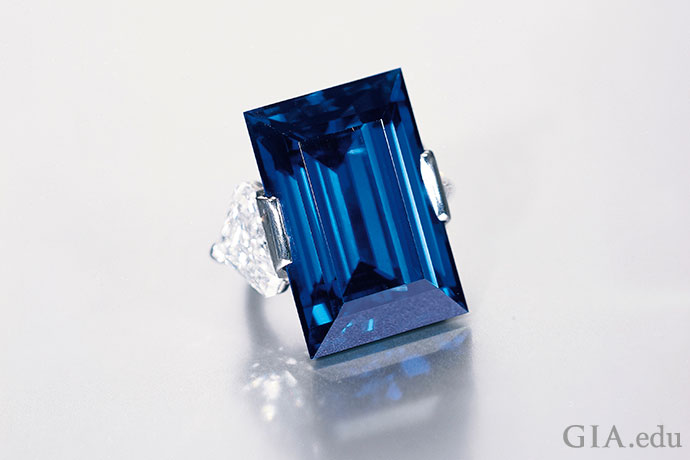
The Rockefeller Sapphire is a 62.02 ct rectangular step-cut sapphire weighing 62.02 ct. Here it is flanked by cut-cornered triangular cut diamonds, mounted in a platinum ring signed Tiffany & Co. Courtesy: Christie’s Images Ltd., 2015
The Starry Night Sapphire is another famous gem. Also originating from Myanmar, the Starry Night Sapphire is a 111.96 ct cabochon-cut gem whose magnificent six-rayed star is a fine example of asterism.
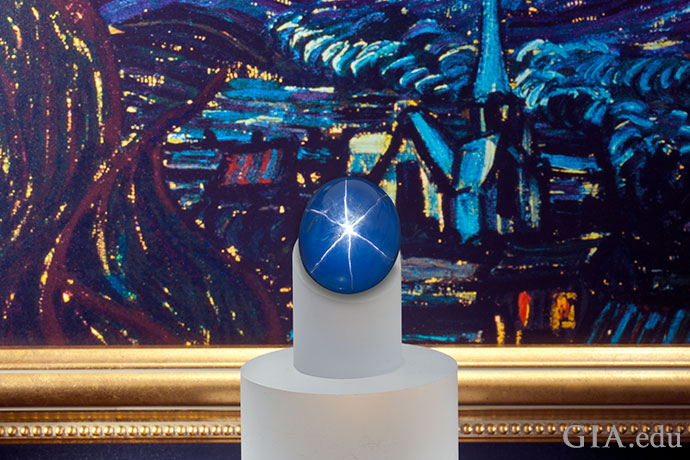
The Starry Night Sapphire comes from Myanmar, one of the most important sources of the gem. The gemological phenomenon asterism is responsible for creating the six-rayed star. Photo: Robert Weldon/GIA. Courtesy: Benjamin Zucker
In addition to being the September birthstone, sapphire is also the gem commemorating the 5th and 45th wedding anniversaries.
Where Sapphire Comes From
Kashmir, Myanmar and Sri Lanka are three historically important sources for sapphire. Significant quantities of the September birthstone have also been found in Australia, Thailand, Cambodia, Madagascar and the United States (Montana), among other countries in Asia and Africa.
Sapphires were discovered in Kashmir around 1881, when a landslide high in the Himalayas exposed a large pocket of velvety “cornflower” blue crystals. As the spectacular sapphires began to appear farther south, the Maharaja of Kashmir—and his army—took control of the new locality. From 1882 to 1887, thousands of large, beautiful crystals were recovered. In this short season of six years rests Kashmir sapphire’s reputation as one of the world’s most coveted gems. Production has been sporadic since then, but auction houses occasionally sell fine pieces of Kashmir sapphire.

A magical pool … a drop of the sky … a slice of eternity. This 3.08 ct cushion cut Kashmir sapphire conjures such visions. Photo: Robert Weldon/GIA. Courtesy: Edward Boehm, RareSource

The Himalaya Mountains are the source of Kashmir’s beautiful blue sapphires. Photo: Robert C. Kammerling/GIA
The Mogok area of Myanmar is another locale famed for producing the September birthstone. Jungle-clad hills hemmed by mountains make a dramatic landscape. Sapphire typically occurs alongside ruby deposits, but in much lower quantities than its red counterpart. ”Burmese” sapphire, as it is still called by many, can possess a rich, intense blue hue, which has made it particularly prized. Myanmar is also a noted source of jadeite jade, spinel, zircon, amethyst, peridot and other fine gem materials.

A scenic view near Mogok rivals the beauty of the sapphires hidden underground. Photo: James E. Shigley/GIA
For more than 2,000 years, Sri Lanka has been a source of fine sapphire. The blue stones mined from the alluvial gravels of this “jewel box of the Indian Ocean” can display remarkable brilliance and saturation. In addition, the island’s milky white “geuda” sapphires can be heat treated to a rich blue color.
Sri Lanka is one of the few sources for padparadscha (from the words for “lotus color” in Sinhalese) sapphires. Poetic descriptions for this light to medium pinkish orange to orange-pink sapphire include “salmon,” “sunset” and ”ripe guava.” Padparadschas are quite coveted and have a very high per-carat value.
This gem-rich island is also home to ruby, spinel, garnet, tourmaline, topaz and many more gems.
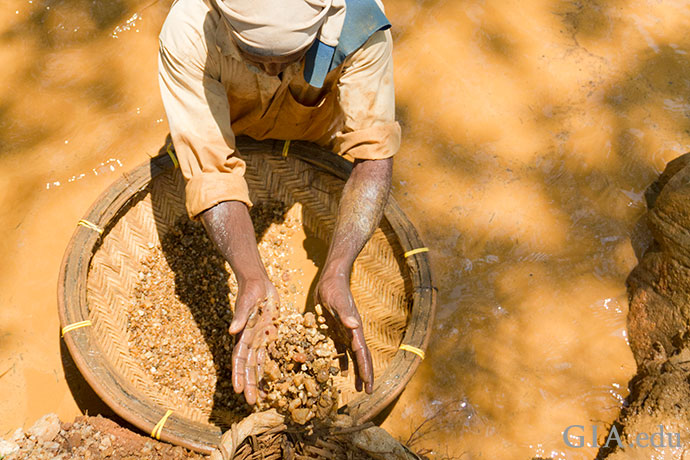
Using the same rudimentary washing techniques as generations before them in Sri Lanka, miners search for sapphire among the gravels in a local stream. Courtesy: Afsaneh Tazari
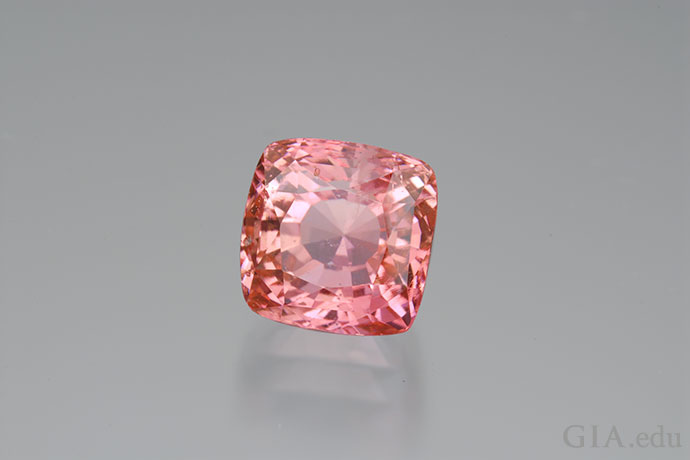
The spellbinding beauty of this 6.66 ct gem from Sri Lanka shows why padparadscha sapphires are so prized. Photo: Robert Weldon/GIA, Dr. Edward J. Gübelin Collection
Thailand is a source of sapphire and a major cutting and treatment center. In dense jungle crossed by dirt roads, miners dig for sapphire in Chanthaburi Province. Sapphires from Myanmar and Cambodia often end up in Chanthaburi for cutting and treatment, and are also sent to Bangkok, an important gem hub.

In the distance, a mining pit dots the tropical terrain of Chanthaburi, Thailand. Photo: Vincent Pardieu/GIA
Sapphire Qualities to Look For
Here are some tips for picking a stunning sapphire.
- Color: The value of most sapphires—both blue and fancy color is based on a combination of hue, tone and saturation. Hue is your first impression of a gem’s basic color. Tone is the darkness or lightness of a color. Saturation is a color’s strength or intensity.
- Each sapphire color has its own quality variations. In general, though, the more intense the color and the fewer zones of unattractive color, the more valuable the stone. The most highly valued blue sapphires are velvety blue to violetish blue, in medium to medium-dark tones. The saturation should be as strong as possible without darkening the tone and compromising brilliance. Blue sapphires with these qualities command the highest price per carat.
- Zoning in sapphires of all colors is common and, especially when apparent in the stone viewed face up, reduces the value of the sapphire. It is important to examine a stone from all angles to determine the presence or degree of zoning before making a purchasing decision.
- Other factors that help determine the value of a sapphire are clarity, cut, proportions, rarity and market demand.
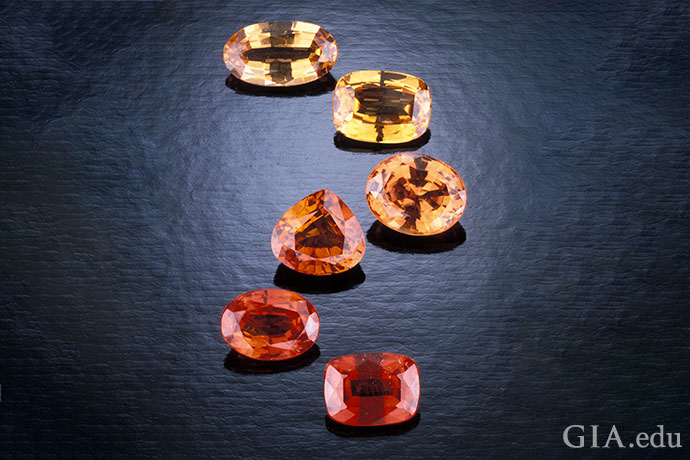
For those who prefer warm-colored gems, the September birthstone does not disappoint. These fancy sapphires range from yellow to highly saturated reddish orange. Photo: GIA & Tino Hammid. Courtesy: Varujan Arslanyan
- Cut: Fashioned sapphires appear most commonly in cushion and oval shapes with brilliant-cut crowns and step-cut pavilions. Blue sapphire cut into trilliant (triangular), emerald, pear and marquise shapes are also available.

The cushion cut is particularly popular for sapphires, like this 4.47 ct blue stone. Photo: Robert Weldon/GIA. Courtesy: Bear Essentials
Asterism in a sapphire will only be revealed if the stone is cut as a cabochon. A finished stone’s attractiveness depends on the star’s orientation and the cabochon’s symmetry, proportions and finish.
Look for a cabochon with a symmetrical outline and a star that’s centered when the gem rests on its base. The dome of the cabochon should be fairly high—about two-thirds of the stone’s width—to focus the star sharply. If it’s too high, the phenomenon loses its graceful motion when the stone is tilted. Excessive height also makes the stone difficult to mount.
- Clarity: Sapphires typically have some inclusions. As a general rule, inclusions make a stone less valuable, and the price can drop significantly if they threaten the stone’s durability. Sapphires with extremely high clarity are rare and very valuable.
- Carat Weight: Sapphires can range in size from a few points to hundreds of carats. Large blue sapphires are more readily available than large rubies. However, most commercial-quality blue sapphire weighs less than 5 carats. Large padparadscha or color-change sapphires are exceedingly rare.

Sapphires are the stars in these earrings. They were especially popular during the Art Deco era of the 1920s and ‘30s, a look that you can get in an engagement ring. Courtesy: Genevive
- Treatments: As you shop, be aware that sapphires are often treated in some way to improve their color and other aspects of their appearance. Heating is one common treatment, particularly for blue sapphires. The results are stable and durable, and heat-treated blue sapphires typically retain their enhanced effects permanently. Because of this, the practice is commonly accepted in the colored stone market.
- Lattice diffusion is another common treatment that can improve color. This involves packing a sapphire into a crucible with coloring agents such as titanium or beryllium, and then heating them almost to a melting point. This allows the elements to enter the stone and alter its color. For example, pink sapphires may turn orange or pinkish orange (padparadscha) with beryllium diffusion. While this treatment is also considered permanent, in some cases (such as titanium-diffused blue sapphire) the added color is so shallow it could be removed if the stone was chipped or had to be recut.
- A less stable, and relatively less common, treatment is the filling of surface-reaching fractures with oil, epoxy, resin or a high-lead-content glass. In some cases, a colored filler is used.
- Sapphires treated with a filler require special care. The filler can be damaged through contact with a variety of chemicals or high heat. Even relatively mild substances like lemon juice can cause alteration of high-lead-content glass.
- Be sure to ask if your sapphire has been treated before you buy. A GIA Colored Stone Identification Report will tell you if a stone is natural or synthetic and whether it has been treated in any fashion.
Sapphire Care & Cleaning
The September birthstone is relatively hard, ranking 9 on the Mohs scale. It has excellent toughness and no cleavage, which is a tendency to break when struck. This makes it a great choice for rings and other mountings subject to daily wear.
Corundum is stable under normal wearing conditions, which means it’s resistant to the effects of heat, light and common chemicals. Boric acid powder will etch the surface of even untreated stones. Fracture-filled, cavity-filled and dyed stones can be damaged by even mild acids like lemon juice.
Warm, soapy water is always a safe choice for cleaning the September birthstone. Ultrasonic and steam cleaners are usually safe for untreated, heat-treated and lattice-diffusion-treated stones. Fracture-filled, cavity-filled or dyed material should only be cleaned with a damp cloth.
Now that you know all about sapphire, you’re probably in the mood to buy a beautiful one. Our Sapphire Buying Guide can help you make a great choice.

